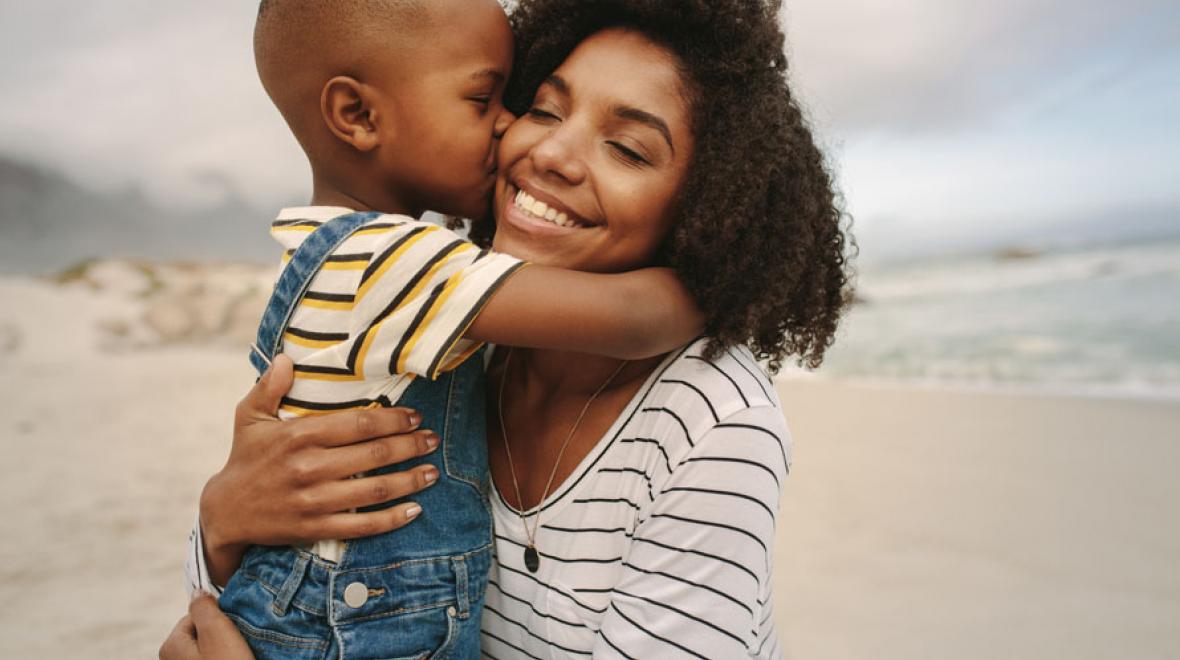
This article is sponsored by Bright Horizons Child Care & Early Education. Learn more about their Bright Spaces program, which creates warm, safe, enriching spaces for children in crisis.
Heaping piles of laundry, help with homework, endless chauffeur services ... No matter the size of the family, what goes into keeping all the parts moving is more than our kids can comprehend. Parenting is a tough job, and often a thankless one, leaving us feeling underappreciated and sometimes even resentful. Sarina Behar Natkin, LICSW, a Seattle-based parenting coach, wants parents to know it doesn’t have to be that way. Cultivating gratitude as a family practice can improve our relationships with our kids and partners, set us up for a more positive outlook, and help us attract more of what we want in life (and from our kids).
“Humans have a strong negativity bias, so we tune in much easier and much quicker to things that are going wrong, the things we don't like, and the bad things that happen. Over time, it shifts our lens. Alternately, if we can shift our perspective to being finders of good, it has a positive impact on our mental health,” says Behar Natkin.
According to her, one of the most common things she sees is parents struggling with burnout, which is compounded when their kids don’t notice or appreciate how much they do for them.
“When parents adopt a wider lens of gratitude, it allows us to lay off our kids a little bit. If we’re hounding them with all that they’re doing wrong, it doesn’t bring them towards us, it makes them want to push away. But if we work in our own lives to see what is good, what we’re grateful for — and when we help our kids learn to do the same — we tend to notice and appreciate each other more.”
So, how exactly do we learn to be “finders of good?” Behar Natkin says it starts with the recognition that cultivating gratitude is a skill that must be learned and practiced.
“We’re not going to teach it in a moment or two, or even 20 or 50 moments, probably — we’re teaching these skills over the whole childhood,” she notes. Don’t be discouraged if it takes a while to catch on.
Behar Natkin shares five ways parents can raise more grateful kids, and hone their own gratitude skills, too.
Helping kids connect with a positive emotion like gratitude is an in-the-moment thing.
1. Understand the meaning of gratitude and learn what it feels like.
Gratitude is not “a forced thank-you,” and while those words can be a great cue for signaling it, they fall short if they’re not authentic.
“Often, parents can get hung up on manners. Saying please and thank you are one way to show gratitude, but saying please and thank you isn’t in and of itself going to make kids grateful,” says Behar Natkin.
Gratitude is a feeling. If we teach our kids what it feels like in their bodies, they can learn to recognize it before it is processed in the brain, which creates a kind of “muscle memory” for the experience.
“We notice pain or anxiety in our body really easily, right? So, helping kids connect with a positive emotion like gratitude is an in-the-moment thing,” she says.
When a child says thank you for something, or a gratitude moment happens, ask them where they feel it. Do they have a warm fuzzy feeling in their tummy? Do they feel a smile coming on? Does their heart feel fluttery? These questions can also be asked when gratitude is expressed to the child when they do something nice or helpful for someone else.
Another great way to help kids connect with the internal experience of gratitude? Bring back the birthday presents. Behar Natkin says that at some point we decided to hold back on birthday gift-giving and opening presents at parties, but when kids have the chance to pick out (or make!) something special for someone they care about, watching them open it allows them to see someone’s reaction to their expression of gratitude in a very tangible way, and puts them on the receiving end of a thank you. And, of course, being the recipient of all the gifts is a great gratitude practice, too.
2. Model behavior
Teaching gratitude starts with you, the parent.
“The way our kids learn is by watching what we do. We have to show them what gratitude looks like in action and modeling is how we do this,” says Behar Natkin.
When we draw attention to “gratitude moments,” which can occur throughout our day, and when we express gratitude to our partners and others, and especially to our kids, it helps them learn to find the good in every situation.
“If people aren’t expressing gratitude to us, it’s hard to understand what gratitude feels like,” says Behar Natkin. “When kids are young, instead of worrying about getting them to spit out a thank you, always modeling it every time will be much more impactful.”
3. Make it a ritual
“Parenting, particularly in the early years, is filled with so much change and chaos. One thing that kids really thrive on is rituals, so finding a way to build it in can be really effective,” Behar Natkin says.
Some families write down or take turns saying three things they’re grateful for each night at dinner or bedtime, which she says can be started even before kids are verbal — by the time they can talk, it will be a normal and welcome part of their routine. Others might start a gratitude jar or keep a journal.
4. Build awareness of the community and the world around us
Behar Natkin says being an aware citizen and helping our kids understand what’s happening in the world is an important part of cultivating gratitude.
“But the way we talk about it matters. Figuring out where we can enter from a positive perspective versus just cycling through the negativity is key” she says.
Asking questions such as, “How do you feel about this?” and “Why do you think others might feel differently?” can help cultivate gratitude because it helps kids connect with what is good in their life. Volunteering is another great family activity that can foster this connection.
Of equal importance, especially with older kids, is teaching them how to be discerning when it comes to the communities they are part of on social media.
“Social media is sort of like the opposite of gratitude,” says Behar Natkin.
She asserts that it focuses so much on superficial things — like material possessions and what people look like — which can make it easy for us to compare ourselves to others and then feel inadequate or jealous.
Behar Natkin recommends having “social media check-ins” where the parent and child discuss who they’re following and how it makes them feel. If an account or community brings about negative emotions, it might be wise to unfollow.
5. Involve the kids
We can’t expect our children to be grateful if they don’t understand the energy it takes to run a household. Chores are the perfect answer to this.
“Finding little ways for our kids to participate from as young an age as possible is critical for building gratitude. Kids love to help out. When they get to experience what goes into living life, they can more fully appreciate it,” says Behar Natkin.
Another great practice for older kids is making a clothing budget in which the child lists everything they need for the year and prices it out (some compromises are made as far as what they actually are allowed to buy, of course). When Behar Natkin did this with her teen daughter, she quickly realized how much things cost and expressed gratitude for what she owned, genuinely reflecting on the outrageous cost of ski pants for a growing-every-year kid. And as a bonus, there was more “buy in” on her daughter’s part, which Behar Natkin said resulted in less lost or misplaced clothing items throughout the year.
|
Sponsored by: |
 |











